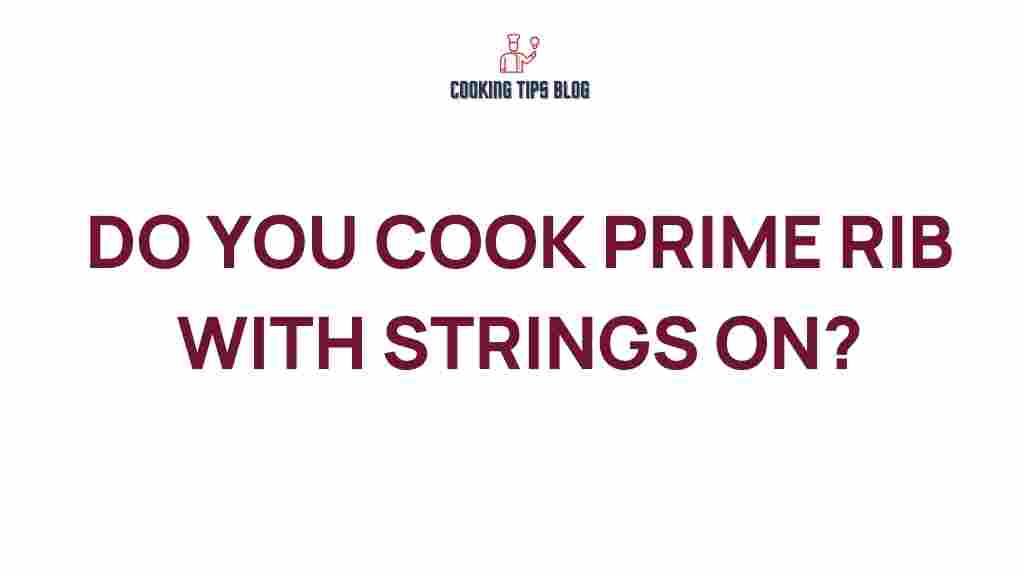Unraveling the Mystery: Should You Cook Prime Rib with Strings On?
When it comes to preparing a succulent prime rib, many home cooks find themselves faced with questions that can impact the outcome of their meal significantly. One of the most common queries revolves around whether to cook prime rib with strings on or off. This article delves into the nuances of cooking prime rib, addressing the string controversy while providing you with tips and tricks for achieving the perfect roast.
Understanding Prime Rib
Before diving into the specifics of cooking prime rib, let’s take a moment to understand what prime rib is. Prime rib, often referred to as a standing rib roast, is a cut of beef from the primal rib section. It’s known for its tender texture and rich flavor, making it a favorite choice for special occasions and holiday dinners.
The cut is generally well-marbled, which contributes to its juiciness. When prepared correctly, it can be the star of any meal. However, proper preparation is key to unlocking its full potential, including the question of whether to keep the strings on during cooking.
Should You Cook Prime Rib with Strings On?
Many prime rib roasts come tied with butcher’s twine or strings to maintain their shape during cooking. Here are the key points to consider regarding this practice:
- Shape Retention: Keeping the strings on helps the roast maintain its shape. This is particularly important for presentation, especially if you plan to serve the prime rib as a centerpiece.
- Even Cooking: The strings can help the roast cook more evenly, as they keep the meat compact and prevent it from flattening out during the cooking process.
- Flavor Infusion: When the roast is tied, the juices and flavors are contained within the roast, enhancing its overall taste.
- Easy Carving: The strings can provide stability, making it easier to carve the roast into even slices.
Based on these benefits, it’s generally advisable to cook prime rib with strings on. However, if you prefer a more rustic presentation or if you’re confident in your butchering skills, you can remove the strings before cooking.
Preparing Your Prime Rib
Now that we’ve addressed the string issue, let’s move on to preparing your prime rib for cooking. Follow these steps to ensure a delicious outcome:
Step 1: Choose the Right Cut
When selecting your prime rib, look for a cut that has good marbling and is at least 2-3 inches thick. A well-chosen prime rib will enhance your overall results.
Step 2: Seasoning
Seasoning is crucial in bringing out the flavors of prime rib. Here’s a simple seasoning method:
- Generously coat the prime rib with kosher salt and freshly ground black pepper.
- Consider adding garlic powder, onion powder, and herbs like rosemary or thyme for added flavor.
Let the seasoned prime rib sit at room temperature for at least an hour before cooking. This allows for even cooking and helps the meat retain its juices.
Step 3: Preheat Your Oven
Preheat your oven to 450°F (230°C). This high initial temperature will help form a crust on the outside of the prime rib.
Step 4: Searing the Roast
Place the prime rib in a roasting pan with the rib side down. Sear it in the preheated oven for about 15-20 minutes. This step is crucial for locking in moisture and flavor.
Step 5: Lower the Temperature
After searing, reduce the oven temperature to 325°F (160°C) and continue cooking until your desired doneness is reached. Use a meat thermometer to check the internal temperature:
- Rare: 120°F (49°C)
- Medium Rare: 130°F (54°C)
- Medium: 140°F (60°C)
- Medium Well: 150°F (66°C)
- Well Done: 160°F (71°C)
Step 6: Resting
Once cooked to your liking, remove the prime rib from the oven and let it rest for at least 20-30 minutes. This resting period allows the juices to redistribute throughout the meat, resulting in a more flavorful and juicy roast.
Common Troubleshooting Tips
Even with the right preparation, you may encounter issues while cooking prime rib. Here are some troubleshooting tips to help you achieve the best results:
Problem 1: Uneven Cooking
If your prime rib is cooking unevenly, consider the following:
- Ensure your oven is calibrated correctly. An oven thermometer can help you check this.
- Use a meat thermometer to monitor the internal temperature accurately.
- Position the roast in the center of the oven for even heat distribution.
Problem 2: Overcooked Prime Rib
To avoid overcooking your prime rib:
- Remove the roast from the oven as soon as it reaches your desired internal temperature.
- Keep in mind that the meat will continue to cook while resting, so aim for a temperature 5-10°F (2-5°C) lower than your target.
Problem 3: Dry Prime Rib
If your prime rib turns out dry, consider these factors:
- Using a higher quality cut with more marbling can help retain moisture.
- Make sure to rest the meat adequately before slicing.
- Consider using a meat injection marinade to enhance moisture.
Conclusion
In conclusion, cooking prime rib with strings on is generally the best practice to ensure a flavorful and visually appealing roast. By following the steps outlined in this article, you’ll be able to prepare a prime rib that’s tender, juicy, and the star of your dining table. Remember to season it well, monitor the temperature, and allow it to rest before serving.
Whether it’s a festive holiday gathering or a special occasion, mastering the art of cooking prime rib will surely impress your guests. For more culinary tips and recipes, feel free to explore our cooking resources. And for those interested in beef cuts and preparation techniques, check out this informative article on prime rib cooking.
This article is in the category Tools and created by Cookingtipsblog Team
